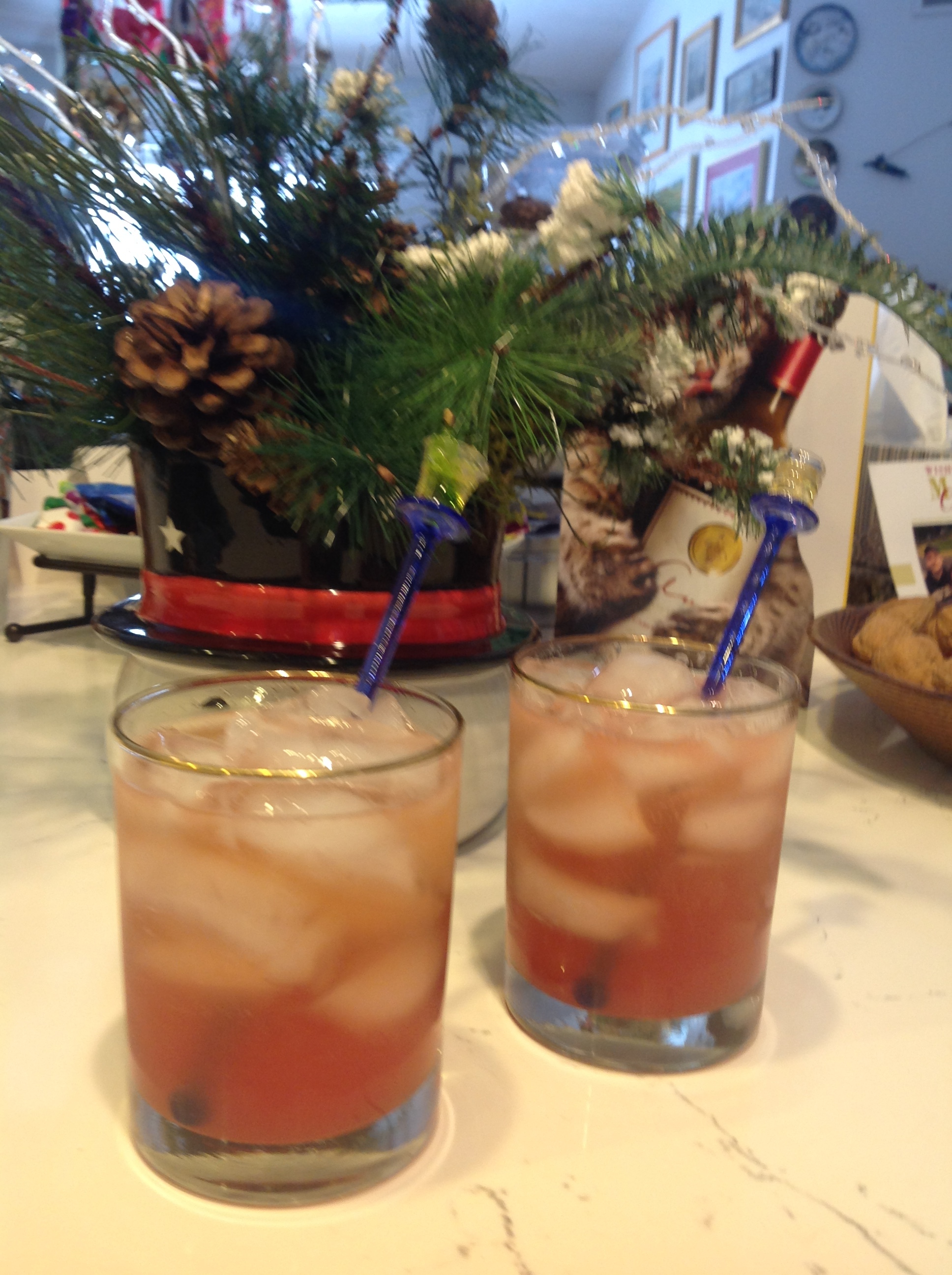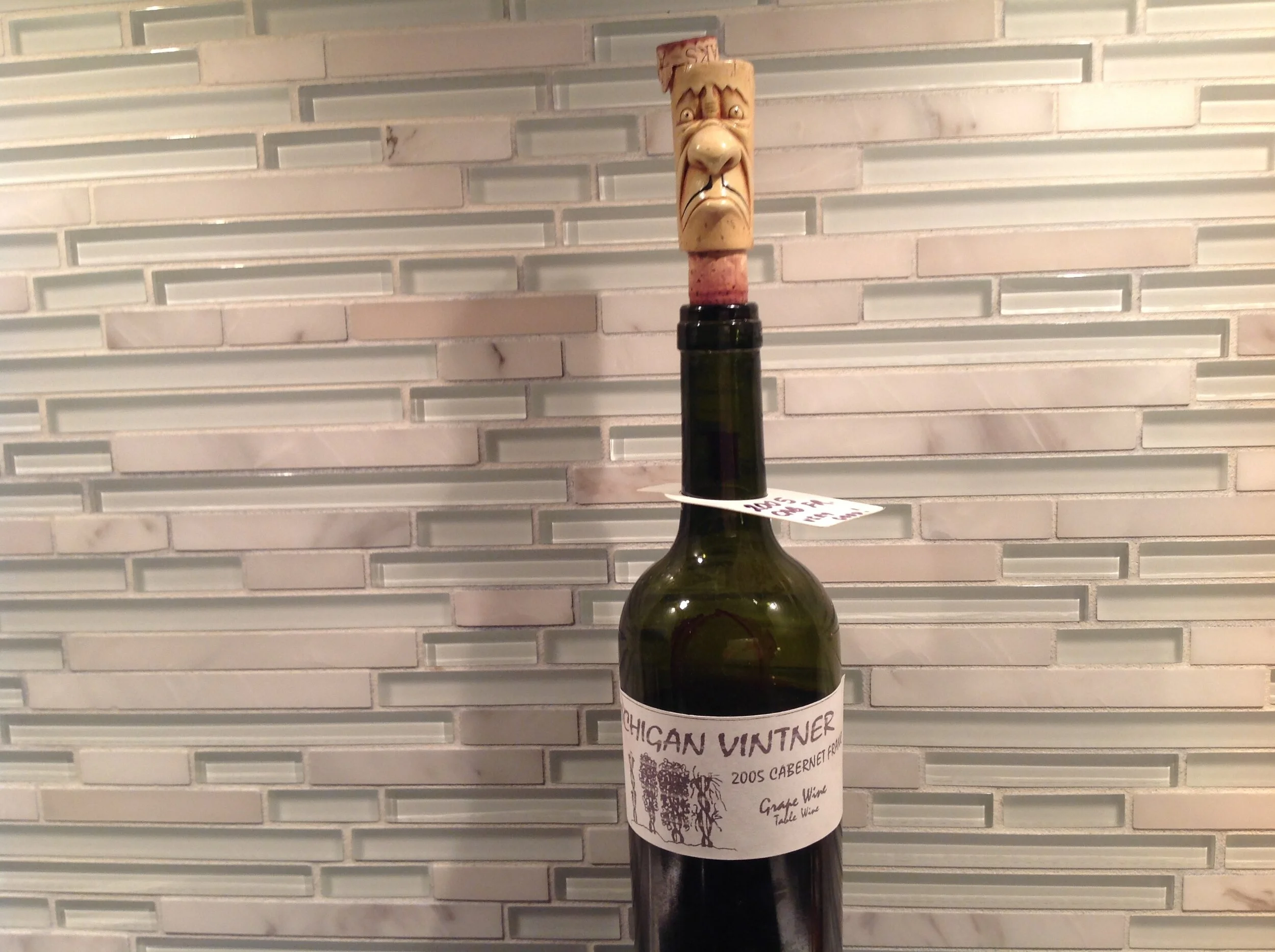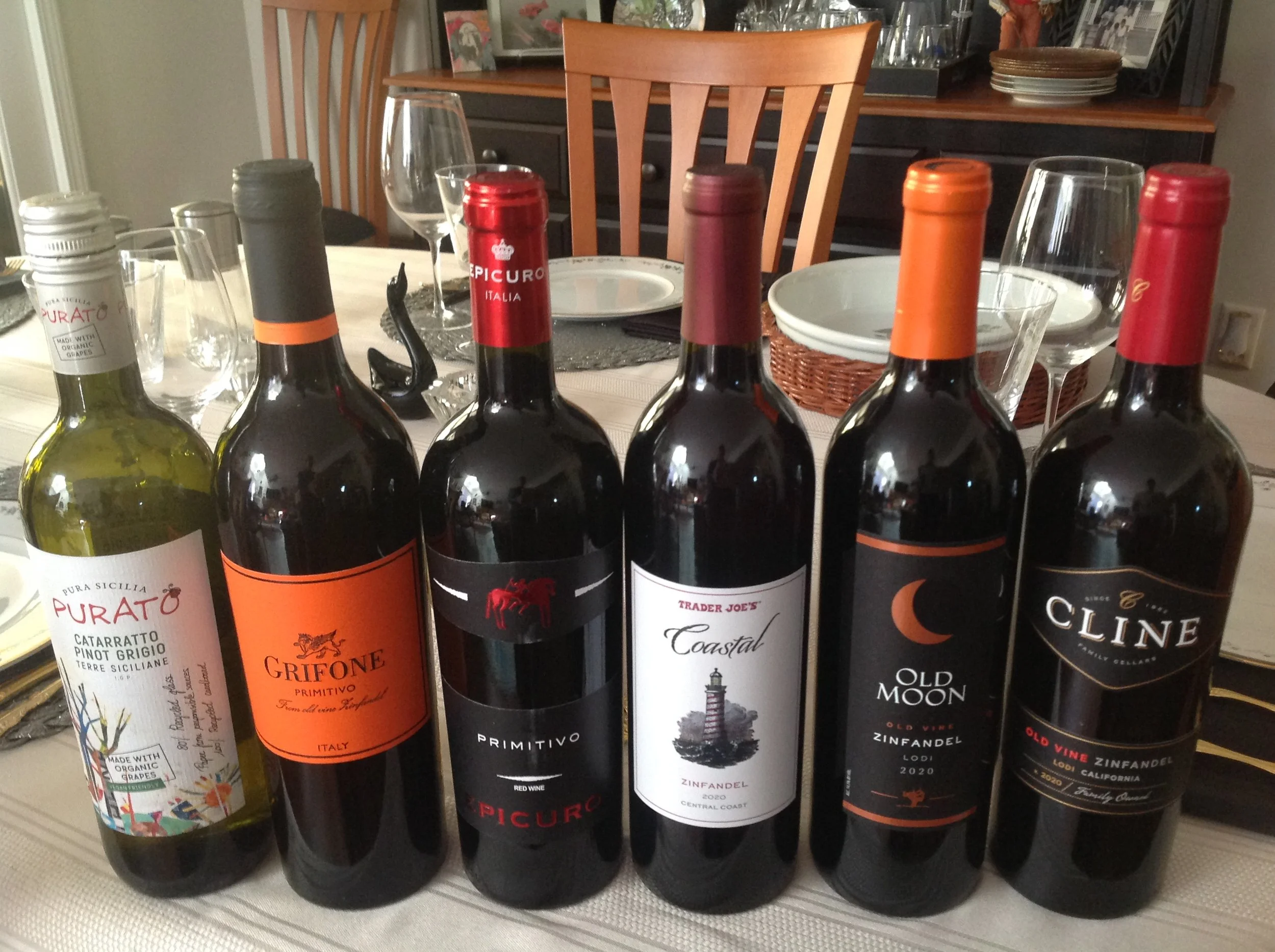A. Rafanelli Zin Update and Festive Cocktails and End of Year Miscellany

Festive Cocktails and End of Year Miscellany
The Donna Reed Cocktail
Pictured is the Donna Reed cocktail. Alice found it in “Wine Enthusiast” magazine while waiting for me in the doctor’s office. For the past several years now, Alice has become very interested in mixology. Whenever we go out, she always seeks a new house specialty cocktail. One of the things I like about the Donna Reed is that it is served with a side of Champagne. Initially, I find the drink just a hair too sweet for my taste, but, as you drink it down, you keep topping off with the Champagne and the drink becomes drier and drier until it is just about pure Champagne with just a zest of the fruity liqueurs. This way too, it lasts a long time by way of continuous topping off.
The Donna Reed Cocktail
To make two drinks, you’ll need:
2 oz. Plymouth Gin [I’ve found that London Dry works equally well]
2 oz. Campari
½ oz. Carpano Antica Sweet Vermouth [again, Punt e Mes or any other intensely flavored authentic sweet vermouth will work fine too]
½ oz. Kalani Coconut Rum Liqueur [which, I couldn’t find and used Malibu with total success]
Grapefruit peelings for garnish
In a mixing glass, stir together first four ingredients with ice. Strain into rocks glass over a large piece of ice [or the largest cubes you have]. Garnish with grapefruit peel. Serve with a small glass or carafe of Champagne [along-side and pour over the cocktail as you drink it].
The 522 North Pinckney Cocktail
When we were in Charleston SC, we stayed at the Andrew Pinckney Inn. The concierge hailed from Kalamazoo MI and was noted for his Pinckney cocktail. We love it in the summer, but, the fresh grapefruit juice makes it a brunch favorite any time of year. Although we didn’t get the recipe at the time, it was later printed in “Bon Appetit” magazine. The original recipe is for a whole punch bowl. I’ve adapted it for two servings below.
522 North Pinckney Cocktail
To make two drinks, you’ll need:
½ cup fresh pink grapefruit juice
½ oz. Campari
1 oz. St. Germain Elderflower liqueur*
6 oz. chilled sparkling wine*
[Pour the grapefruit juice, Campari and St. Germain into a mixing glass with ice. Shake vigorously and divide between two glasses with ice cubes. Top with sparkling wine.]
*The first time I made this, I didn’t have any Elderflower liqueur in my bar so I substituted 7 oz. of Il Mionetto Elderflower Prosecco for the last two ingredients. It worked equally well, maybe better.
Pulling out long overlooked bottles of wine is one of my favorite holiday traditions. For some stupid reason, it sometimes feels wasteful to open a mature bottle of great wine that may have a replacement value in the hundreds of dollars for an everyday meal. Why not make that everyday meal something special with a great bottle of wine? Good question; and one that doesn’t seem to get answered often enough.
So, what better reason to open one of those salted away bottles than a holiday meal? Really though, just because the sun came up should be a good enough reason to open the most prized bottle in the cellar. So, here are some of the highlights from our holiday wines.
I publish these notes not because I assume you have these very same wines in your cellar too, but, just as a suggestion that if you have wines of comparable age, maybe you should consider drinking them and if you have similar wines that are much younger, maybe you should consider saving them for a while longer.
2005 A. Rafanelli Dry Creek Zinfandel Here is a perfect example of opening a great bottle of wine for no particular reason. We had enjoyed a restaurant meal at noontime and while watching the Lions get a cruel dose of reality, we felt like a snack and a glass of wine and Alice stressed a good glass of wine. So, why not pull out a great Zin that was clearly way too old to serve at OZ (see blog posts October 13, 2017 and October 1, 2018). It still had very deep color though a little “bricky” at the edges. The aroma explodes with a massively dense concentration of black truffles, creosote and dried fruits and lasts as it glides across the palate and holds strong throughout the long finish. When you read “tar”, “creosote” and “truffle” I’m sure OLD comes to mind. However, this wine doesn’t seem old. It is as massive, yet fresh, as any wine I’ve tasted lately and reminds me of a mature St. Joseph (Northern Rhone) or a blockbuster Chateauneuf du Pape (Southern Rhone) though it is truly a wine without equal. It was the perfect wine with strong cheese and dry aged Iberian sausage.
UPDATE: 10/21/2020
We enjoyed a Zoom meeting due to COVID social distance last night featuring Zinfandel in honor of Rik “Dr. Zin” Vydareny and his wife Kitty who had planned on hosting tonight’s event, had we not all been sheltering in place. So, Alice and I decided to open the stablemate to the 2005 Rafanelli, a 2006 A. Rafanelli Dry Creek Zinfandel. Compared to a lot of Zins these days, this wine had a relatively mild alcohol content of 14.8%. As I taste these old Zinfandels, what strikes me is how the unique annual weather each year stamps an indelible character upon the wines which becomes much more apparent as the varietal fruit fades and the terroir and circumstance of vintage begin to shine. Unlike the 2005, which was a big dense brute, the 2006 was remarkably Bordeaux-like. It showed enormous class and depth of flavors beyond the varietal fruit. I would certainly not guessed Zin in a blind tasting, probably Cabernet or Merlot. A fine cedar forest like scent permeated the milder black fruit nuances. The wine had lots of fine tannin, not typical of Zinfandel coating the palate in a silky lip-smacking blanket. Though maybe not quite as big as the 2005, I think I prefer it. What a thrill to taste mature Zinfandel!
We still have a bottle of 2007. Our friend LeeAnn Olson gave us a couple old bottles of A. Rafanelli Zin several years ago, we also bought some bottles at an AWS auction so I’m scratching my head trying to remember drinking the others. We must have done so prior to my starting this blog and recording our wine adventures.
1979 Ockfener Bockstein Riesling Spatlese, Dr. Fischer This was another of the wines we purchased from Sue Beadle after her husband John passed away. I inform you about this wine not because I expect any of my readers to have a bottle, but, to illustrate the longevity of Riesling when grown in classic vineyard locations by producers with a long track record of making great wines that have withstood the test of time. If you don’t have any younger wines comparable to this, you should! The best place in Michigan to buy them is the Village Corner in Ann Arbor, but, you can buy some of these iconic wines locally too. And, by the way, if you are up in Traverse City, be sure to stop in and see my old buddy Ric Cerrini who owns Bon Vin on 8th street. He not only stocks great German estate wines, but also has a pretty impressive selection of mature classic German estate wines. On the nose, the ’79 Ockfener has star fruit and mango along with berry, fruit blossoms and almonds. The palate is still bright and clean with fresh acid and a light nuance of toffee and allspice. In the finish a long memory of honey, resin and ripe mango persist.
2000 Quintessa Napa Valley Rutherford Red Wine Here is a fully mature example of stylish Napa Meritage. It is certainly not a massive fruit bomb, but, rather an elegant silky smooth wine of the finest breeding and balance. The dark red color has just the hint of a slightly orange rim. On the nose, slightly toasted woodsy forest floor smells combine with just a subtle hint of plum brandy. It is delicate on the palate, very soft with fine grained tannins. It finishes with baked rhubarb and strawberry with nuances of cocoa and red fruit around the edges of the tongue. Is such a wine worth $200? Obviously, I didn’t pay that much back when I bought it 15 years ago nor would I ever pay that much for a current bottling. Though it is clearly in a league with comparably priced Grand Cru Classe Bordeaux, I don’t buy them anymore either. Most of the Bordeaux futures that I purchased from the great 2015 vintage were under $15 and I expect will be every bit as good or better than wines like Quintessa or Grand Cru Classe Bordeaux. I almost never find that the very expensive bottles are any more enjoyable than the wines for under $25 and often not as good. For example, the A. Rafanelli Zin or the JLChave Offerus we had recently were vastly more interesting.
1998 Chateau Poujeaux, Moulis in Medoc, Cru Bourgeois Exceptionel The color is quite similar to that of the Quintessa; maturing but still deep red and vibrant. Ripe, herbal, compost scents, dried fruit and brandied cherries along with subtle suggestions of tobacco and cedar on the nose combine with dusty, earthy flavors giving way to black truffles, pine needles and black earth on the palate. This is a pretty robust example of left bank Bordeaux. Like the Quintessa, is has a good measure of Cabernet Sauvignon in the blend with Merlot and Cabernet Franc. Both of these wines are fully mature yet the fine balance and silky finish suggests several more years of holding well before going over the hill. And, although the Poujeaux is a bigger more interesting wine than the Quintessa, it is probably not as versatile. We enjoyed the Quintessa with Costco prime rib collar pinwheel steaks, but, it could have been just as good with salmon, veal or roasted chicken. The Poujeaux, on the other hand, demands red meat. We paired it with chateaubriand and Bearnaise sauce.
1995 Pacherenc du Vic Bilh, Collection Plaimont – Union de Producteurs There’s a mouth full! Best as I can figure, the pronunciation is something like patch-er-ons du-vic bill. This is a dessert wine from a relatively dry region where botrytis is not all that common except in the great vintages of the top estate wines. So, even though the wine is very ripe with resinous late harvest characteristics it does not resemble the exotic, apricot-passion fruit laden flavors found in other sweet French wines such as Sauternes or Cadillac for example.* It is deep amber gold with a nose full of resin, beeswax, baked apples, honeydew and cola. On the palate Indian spices, anise, more resins and a persistent memory of dried apricot, pear and apple stay to the finish. It wasn’t sweet enough to pair well on Christmas Eve with our cream leche custard but, Christmas day, it went beautifully with poached pears in spicy wine sauce.
*Here’s a trivia question for your next dinner party where someone brings out a “rare” sweet Bordeaux white wine.
Q: Of the 13 white wine producing Appellations in Bordeaux, how many designate dry wines only, sweet wines only and some dry/some sweet?
A: 2 dry only [Entre deux Mers and Pessac Leognan], 9 sweet only [St. Foy, St. Macaire, St. Crox du Mont, Sauternes, Barsac, Loupiac, Cerons, Cadillac and Graves Superieur] with 2 [Graves and Bordeaux/Bordeaux Superieur] producing both.
So, sweet white Bordeaux wine may be somewhat rare in the US, but it is in fact the rule and not the exception in France.
Enjoy in Good Health, the Michigan Vintner






